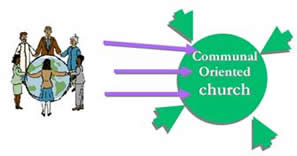A Fatal Trend
When we were missionaries in Pakistan there was a time when “church planting” became the standard for our team – it was the tie to church planting that validated the ministries we were involved in. However, the demand for a direct church planting connection resulted in an analysis and critique of the definition of “church planting” that stretched it to fit everyone’s particular ministry. Rather than maintaining a clearly defined role within our mission along side of other important ministries, church planting became so broad in scope and fuzzy in meaning that it ceased to be a helpful measurable concept. Once everyone is a church planter, the impact, purpose and role of a church planter loses its significance and unique purpose. In order to maintain its usefulness, the term either needs to be replaced with a more helpful term, or it needs to be redefined with careful boundaries, excluding those activities that can be defined with other terms.
The term “missional” is in danger of a similar fate. As a description of the primary orientation of a church to bring gospel transformation in the world, it is in danger of losing its usefulness and impact. It has become a popular buzzword to describe practically any church that has an outreach program. Because articles on the missional church often state that all churches must be missional in order to be legitimate expressions of the body of Christ, the meaning of the term has been broadened and stretched beyond its original intent. However, it is neither a given that a growing, healthy church is missional, in the original sense of the term, nor that being missional will necessarily result in a growing, healthy church as traditionally understood.
Missional Vs Communal
 “Church” can be described as the communal relationship between followers of Christ within which spiritual growth occurs. This definition encompasses both communal oriented and missional orientated local congregations. However, a missional church is different from a communal oriented church because it is the communal relationship between followers of Christ that stems from intentional Gospel transformation in the world. Its primary reason for being is to demonstrate the relevance of the gospel within societal contexts (i.e., outside of the four walls of the church) and all other aspects of church life are shaped to fulfill that one purpose.
“Church” can be described as the communal relationship between followers of Christ within which spiritual growth occurs. This definition encompasses both communal oriented and missional orientated local congregations. However, a missional church is different from a communal oriented church because it is the communal relationship between followers of Christ that stems from intentional Gospel transformation in the world. Its primary reason for being is to demonstrate the relevance of the gospel within societal contexts (i.e., outside of the four walls of the church) and all other aspects of church life are shaped to fulfill that one purpose.
 A communal church, on the other hand, is the communal relationship between followers of Christ as an expression of the transforming power of the Gospel. Even as Zion in the Old Testament was intended as an expression of God’s glory on earth drawing all nations to salvation and worship, so the communal oriented church seeks to be an expression of the kingdom through its programs and thus invite people into membership with them.
A communal church, on the other hand, is the communal relationship between followers of Christ as an expression of the transforming power of the Gospel. Even as Zion in the Old Testament was intended as an expression of God’s glory on earth drawing all nations to salvation and worship, so the communal oriented church seeks to be an expression of the kingdom through its programs and thus invite people into membership with them.
It is important to maintain this distinction in order to validate each approach within its appropriate context.
Undermining the Missional Concept
i. Confusion with Communal issues
The tendency to weaken the import of the missional term can be illustrated from Milfred Minatrea’s book Shaped by God’s Heart. The problem is not that he fails to describe missional accurately (1) but that he goes on to expand the “missional” definition so that it becomes synonymous with “healthy” and therefore includes inward focused yet positive actions of churches within the missional concept. By contrasting “missional” (good) with “maintenance” (bad) churches, he does not leave any room for positive expressions of the body of Christ that do not have a missional focus as their primary orientation.
For example, Minatrea constantly uses the phrase “missional churches are…” followed by a description which can be true of many non-missional but active churches such as “the missional church understands that prayer empowers” (2). Minatrea’s motive is to provide a holistic description of the missional church, but many of the descriptions provided relate not to missional, but to communal issues. While a holistic view of the missional church is needed, the confusion between communal and missional concepts detracts from the essence of the missional church in its primary, outward orientation to the world.
ii. Leadership
Similarly, a “missional leader” for Minatrea is synonymous with a visionary leader who holds “a vision for what the church might become” (3), rather than emphasizing the unique role of leading people into a transforming engagement with the world. He writes further, “Ultimately, such missional leaders are shaping the culture of their community” (4). If “community” referred to the society and context within which the church finds itself, this statement would be correct. However, because he is actually referring to the believers within a particular congregation, this cannot, by definition, be the “ultimate” goal of the missional leader because it is inward. The ultimate goal for the missional leader must be the same as the missional church: to bring about God’s reign in the world. The means towards the ultimate missional goal is to shape the culture of the congregation.
iii. Worship
A further example of this confusion with a communal orientation is in the treatment of worship. He states, “Worship is designed to exalt God, not to entertain people” (5). In creating this straw man of churches that are interested in entertaining, he ignores the essence of the missional church’s stance that worship is a reflection of and response to God’s glory revealed through His missional activity in the world. The churches in this passage reflect a more inward focused communal orientation which can be illustrated by the statement that “Missional communities invite those who do not yet know God to join experiences of worship, knowing their encounter with God’s Spirit might draw them closer to personal relationship with Him” (6).
iv. Equipping
Minatrea’s claim that “Successful equipping involves movement from information through contemplation to transformation” (7) also lacks a missional focus. It assumes that equipping begins with information and leads to action, i.e., from the abstract to the concrete. This modernist approach to education reflects communal church values that begin with God’s people in God’s presence and invites other in. In contrast the missional church begins with God’s people interacting with others in the world and lets the contemplation of God’s word address the issues that arise from those relationships. Both approaches can lead to a “pastoral circle” (8) of moving between God’s word and culture, but only the latter approach intentionally initiates and ensures relevant interaction with the world.
v. “Missional Assessment” Check lists
The strength and value of the missional concept lies in an outward focus as the core purpose of the church. All other aspects of the missional church are shaped to facilitate this one vision, that as the people of God we are chosen for others. Any attempt to measure the missional aspect of a church must focus on this outward orientation. Unfortunately, the “missional assessment” check lists in Shaped by God’s Heart often fail in their professed purpose because there is no connection to a distinct missional concern. For example, “members are equipped to practice spiritual disciplines” (9) is not a concern unique to missional churches. A better analysis of missional focus would be “members are equipped with those spiritual disciplines which empower them to bring transformation within their particular context.” Rather than “We have a high regard for God’s Word” a better analysis would be “members use their Bibles effectively and relevantly in making an impact in the community outside the church.”
vi. Community
In addressing the issue of community, Minatrea states “One means of achieving unity in a missional community is to state clearly what is expected of members” (10). This communal focus loses the important missional orientation that insists on keeping an outward vision as the driving force behind the involvement of the members. Unity in the missional church emerges through the passion to fulfill a goal in the world, rather than conformity to a covenant to “invite my friends … to church” and “pursue spiritual worth in a 360 Community through Bible Study [and] fellowship….” For the missional church it is not “clear expectations for members” (11) that fulfills this “missional practice,” but a commitment to gospel transformation in the world.
Centered vs Bounded
A fundamental structural difference between missional and communal oriented churches lies in the difference between “centered” and “bounded” sets (12). Both Frost and Minatrea provide excellent examples of this distinction that will be explored in the following article.
- _______________
- (1) For example see the good contrast between “missions-minded” and “missional” in Milfred Minatrea, Shaped by God’s Heart: The Passion and Practices of Missional Churches (San Francisco: Jossey-Bass, 2004), 11.
- (2) ibid., 151.
- (3) ibid., 161.
- (4) ibid., 168.
- (5) ibid., 66.
- (6) ibid., 66-67.
- (7) ibid., 56.
- (8) J. Holland and P. Henriot, Social analysis. Linking faith and justice (Revised and enlarged edition, Maryknoll: Orbis 1983).
- (9) Minatrea, Shaped by God’s Heart, 64.
- (10) ibid., 34.
- (11) ibid., 30.
- (12) Michael Frost & Alan Hirsch, The Shaping of Things to Come: Innovation and Mission for the 21st-Century Church (Peabody: Henderson, 2006), 47.
